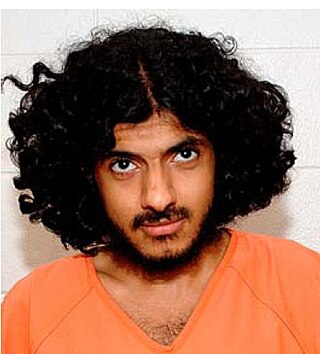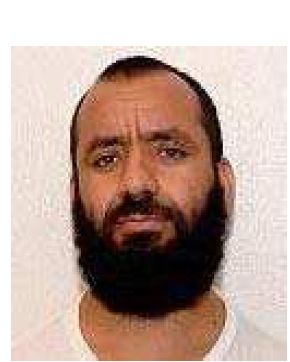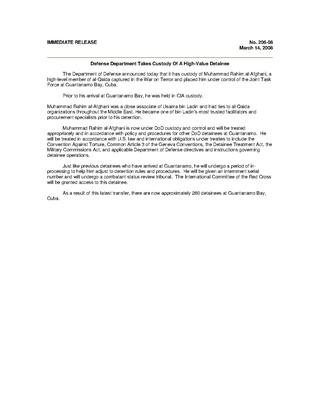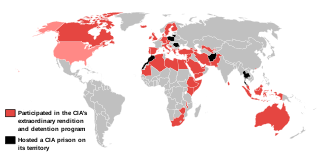Related Research Articles
Ghost detainee is a term used in the executive branch of the United States government to designate a person held in a detention center, whose identity has been hidden by keeping them unregistered and therefore anonymous. Such uses arose as the Bush administration initiated the War on Terror following the 9/11 attacks of 2001 in the United States. As documented in the 2004 Taguba Report, it was used in the same manner by United States officials and contractors of the Joint Interrogation and Debriefing Center at the Abu Ghraib prison in Iraq in 2003–2004.

The Salt Pit and Cobalt were the code names of an isolated clandestine CIA black site prison and interrogation center outside Bagram Air Base in Afghanistan. It was located north of Kabul and was the location of a brick factory prior to the Afghanistan War. The CIA adapted it for extrajudicial detention.
Abed Hamed Mowhoush was an air vice-marshal believed to be in command of the transport, logistics and airlifting division of the Iraqi Air Force during the regime of Saddam Hussein immediately prior to the 2003 Invasion of Iraq, until his surrender to United States forces on 10 November 2003. He died on 26 November 2003 while in U.S. custody at the Al-Qaim detention facility approximately 200 miles (320 km) northwest of Baghdad, following a 16-day period of detention.

In 2005, The New York Times obtained a 2,000-page United States Army investigatory report concerning the homicides of two unarmed civilian Afghan prisoners by U.S. military personnel in December 2002 at the Bagram Theater Internment Facility in Bagram, Afghanistan and general treatment of prisoners. The two prisoners, Habibullah and Dilawar, were repeatedly chained to the ceiling and beaten, resulting in their deaths. Military coroners ruled that both the prisoners' deaths were homicides. Autopsies revealed severe trauma to both prisoners' legs, describing the trauma as comparable to being run over by a bus. Seven soldiers were charged in 2005.
Extrajudicial prisoners of the United States, in the context of the early twenty-first century War on Terrorism, refers to foreign nationals the United States detains outside of the legal process required within United States legal jurisdiction. In this context, the U.S. government is maintaining torture centers, called black sites, operated by both known and secret intelligence agencies. Such black sites were later confirmed by reports from journalists, investigations, and from men who had been imprisoned and tortured there, and later released after being tortured until the CIA was comfortable they had done nothing wrong, and had nothing to hide.

Hassan Muhammad Salih bin Attash is a citizen of Saudi Arabia, held by the United States in the Guantanamo Bay detention camp in Cuba. Joint Task Force Guantanamo counter-terrorism analysts estimate that bin Attash was born in 1985, in Jeddah, Saudi Arabia.

Khaled Ahmed Qasim is a Yemeni citizen who has been held in extrajudicial detention in the United States Guantanamo Bay detention camp in Cuba, since May 2002.

Maasoum Abdah Mouhammad, a citizen of Syria, was formerly held in extrajudicial detention in the U.S. Guantanamo Bay detention camps, in Cuba.

Muhammad Ali Abdallah Muhammad Bwazir is a citizen of Yemen, once held in extrajudicial detention in the United States Guantanamo Bay detainment camps, in Cuba. Bwazir's Guantanamo Internment Serial Number was 440. American intelligence analysts estimate he was born in 1980, in Hawra', Yemen.
Abdul Qayyum "Zakir", also known by the nom de guerre Abdullah Ghulam Rasoul, is the acting Deputy Minister of Defense of the Islamic Emirate of Afghanistan. He previously served as the acting Defense Minister, from 24 August 2021 to 7 September 2021.

Muhammad Rahim is an Afghan who is held in captivity by the United States Government at Guantanamo Bay. He was born in eastern Afghanistan. Muhammad Rahim worked for an Afghan government committee that worked to eliminate opium poppies from the nation. He was forced to leave his job by the Taliban. In 1979, Rahim fled Afghanistan with his brother over the border of Pakistan. Their departure was triggered by the Soviet Union invasion into Afghanistan.
The black jail was a U.S. military detention camp established in 2002 inside Bagram Air Base, Afghanistan. With the withdrawal of U.S. troops from Afghanistan, it is no longer in operation. Distinct from the main prison of the Bagram Internment Facility, the "Black Jail" was run by the U.S. Defense Intelligence Agency and U.S. Special Operations Forces. There were numerous allegations of abuse associated with the prison, including beatings, sleep deprivation and forcing inmates into stress positions. U.S. authorities have refused to acknowledge the prison's existence. The facility consisted of individual windowless concrete cells, each illuminated by a single light bulb glowing 24 hours a day. Its existence was first reported by journalist Anand Gopal and confirmed by many subsequent investigations.
Hamidullah is a citizen of Afghanistan who was held in extrajudicial detention in the United States' Bagram Theater Internment Facility. He was interviewed by The New York Times in November 2007, and gave an account of his detention, first in "the black prison" and then in Bagram. On November 28, 2009, Allisa J. Rubin published an article in The New York Times which reported on Hamidullah's description of his detention.
Camp No is an alleged secret detention and torture facility related to the United States detainment camps located in Guantánamo Bay, Cuba. On January 18, 2010, Scott Horton asserted in an article in Harper's Magazine, the result of a joint investigation with NBC News, that such a facility was maintained outside the regular boundaries of the Guantanamo Bay detention camps.
Ismatullah is a citizen of Afghanistan. According to Asia Times Ismatullah, a resident of Khost, "simply vanished" in the winter of 2009, after hanging out with some friends at the bazaar. Months after his disappearance his family received a letter, through the Red Cross. Ismatullah wrote that he had been apprehended on his way home from the bazaar. He was currently held in extrajudicial detention in the United States' Bagram Theater Internment Facility, and didn't know when he would be released.
Azzimuddin is a citizen of Afghanistan who was held in extrajudicial detention in the United States Bagram Theater Internment Facility, in Afghanistan. He was released on May 15, 2010, after approximately three months of detention. Ten other Afghans were released at the same time as he was. The Miami Herald described their release as a symbolic gesture.

The Afghanistan night raids were a military tactic employed by the United States and Afghan special forces during the War in Afghanistan that lasted from 2001 to 2021. The coalition forces in Afghanistan maintain the Joint Prioritized Effects List (JPEL) of targets their special forces try to capture or kill. Using night vision equipment, US and Afghan special forces would raid the suspected households of targets on the Joint Prioritized Effects List. The operations were controversial, due to issues like civilian casualties.
Rish Khor camp is located near Kabul city in Afghanistan.

CIA black sites refer to the black sites that are controlled by the CIA and used by the U.S. government in its War on Terror to detain enemy combatants.
Zaiwalat, also Zaywalāyat or Zywlayt is a subdistrict and village of Jalrez District, Maidan Wardak Province, Afghanistan. It lies along the Kabul-Behsud Highway, to the west of Kot-e Ashro and to the east of the town of Jalrez. As of 2010 the village itself had a population of about 300 people. It is inhabited mainly by Pashtuns and is a producer of fruit, with extensive orchards in the vicinity.
References
- 1 2 3 Anand Gopal (2010-01-30). "Terror comes at night in Afghanistan". Asia Times. Archived from the original on 2010-02-01. Retrieved 2010-01-29.
One example, according to former detainees, is the detention facility at Rish Khor, an Afghan army base that sits atop a mountain overlooking the capital, Kabul.
{{cite news}}: CS1 maint: unfit URL (link) - ↑ Mohammed A. Salih (2010-01-29). "AFGHANISTAN: US Night Raids and Secret Prisons Anger Civilians". Inter Press Service. Archived from the original on 2010-02-01.